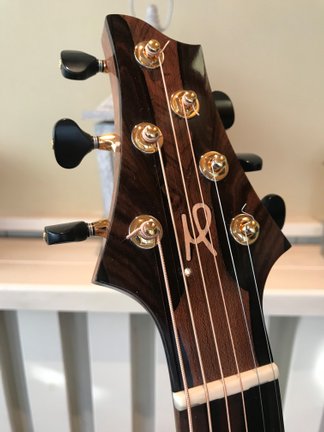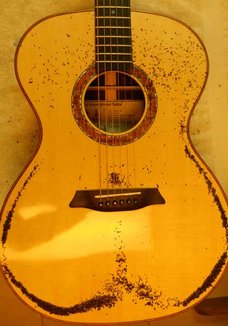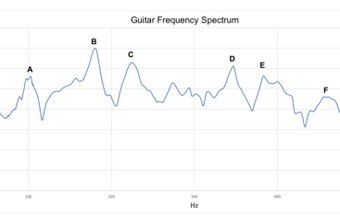Murphy Custom Guitars
Handcrafted Acoustic Guitars
Drogheda, Co Louth, Ireland.
Side Mass
The sides of a guitar do much more to shape the sound of a guitar than people realise.
For years luthiers have observed that guitars made with the stiffer side woods had greater volume and projection.
With limited test equipment available to guitar builders at the time, it was very difficult to prove. But it was an observation that had been made by many luthiers.
We have seen many luthiers use techniques to stiffen the sides of a guitar.
Some glue on extra braces, some use laminated sides. All in a bid to improve the sound of
their guitars.
All of these advancements were definitely a move in the right direction. But it was
research carried out by Trevor Gore and Gerard Gilet that actually proved that the sides of a guitar, actually do contribute to the guitars sound.
They even brought it a step further and developed a techinique that can actually shape the sound/tone of a guitar.
This research led Gore to write 150 page paper on his findings with all the maths and physics to back it up, which he later published it in his book. This research confirmed what many luthiers believed in the past
"That stiffer sides increased volume & projection."
Gore & Gilet actually observed that it wasn't necessarily the stiffness of the sides,
but it was the density/mass of the sides that caused the increase in volume & projection.
Trevor Gore has often used a firmarm analogy to simplify how it works:
"When you fire a gun the bullet accelerates out of the barrel and the shooter experiences a recoil from the gun – the gun accelerating towards the shooter. If you immobilise the gun e.g. by holding, say, the butt of a rifle against a tree, or by making the gun heavier, the gun accelerates backwards less and the bullet accelerates forwards more."
Trevor Gore
The same principle can be applied to a guitar top.
If we immobilise the sides or make them heavier...... the top will accelerate more.
More Movement = More Sound
Using Chladni patterns you can visually see the affect of adding mass to the sides.
If we sprinkle dust or tea leaves (I use tea leaves)on two guitars, one with side mass and one without. Then excite the two guitars to certain frequencies. At different frequencies the tea leaves will move to a point where there is no vibration (called a "node"). These patterns that are created are called Chladni patterns.
On a typical guitar (without sidemass) the nodal line forms around the lower bout. Usally about 40-50mm in from the edge.
On the guitar with mass added to the sides, we observe that the nodal line of the Chladni pattern moves to the outer edge.
What this illustrates to us, is that we are now using all of the lower bout, instead of a percentage of it.
Right Image from:
tommillerguitars.com
Chladni Pattern on the left is
Monopole Mode (T(1,1)2) of a typical guitar.
When side mass is added the ring in lower bout will move out to the edge of the guitar, making a more effective soundboard.
This improvement in efficiency gives us more volume and projection because:
1) It has now has a larger effective area
(i.e. it is using the whole of the lower bout, instead of only using about 60% of it).
2) We are not losing energy into the sides. This energy is reflected back into the top,
making the top more efficient.
Monopole mode(T(1,1)2) would be peak B on the frequency spectrum graph.
By adding/removing mass to the sides of a guitar, you can actually move the frequency of this peak.
By adding mass to the sides we now have observed an improvement in the efficiency of the top, but we have also observed a decrease in the frequency(hz) of the monopole mode(T(1,1)2) of the top. The more mass that is added, the more the frequency drops.
The ability to fine tune the frequency at which the top vibrates at, is what makes this so important. Before now you would have to put your hand through the soundhole and carve the brace and this was a long and very tedious job. This could also be detrimental to the integrity of the guitar if you carve off too much. Easy to take wood off, a lot harder to put it back on.
The frequency drop of the monopole mode is also an important characteristic of adding mass. As discussed on the Modal Tuning/voicing section of my website, changing the Frequency of the different modes of a guitar, changes how the guitar sounds(it's Tone).
This gives you far greater control of how the guitar sounds.
This is a real breakthrough in voicing guitars, being able to fine tune the frequencies(hz) at which the guitar vibrates at by added or removing mass from the sides.
All Murphy Guitars have had the ability to add side mass for a few years now and in my opinion, the benefits outweigh any extra weight in the guitar (100g-400g). Majority of guitars I have built with side mass, weight no more than a guitar with a built in pre-amp system.
Adding side mass improves:
1) Increased Volume & Projection.
2) Increased Bass Response- has a darker, fuller sound without being boomy.
3) Adds an extra shimmer/sparkle to the trebles, which balances out the extra bass & gives you a more balanced guitar.
4) Finer control over the voicing/overall tone of the guitar.
To me its a win-win situation! If you don't like the extra weight in the guitar they are easliy removed and re-installed inside the guitar through the soundhole.



